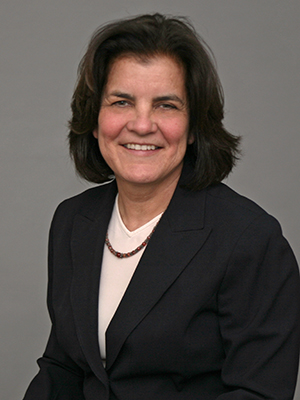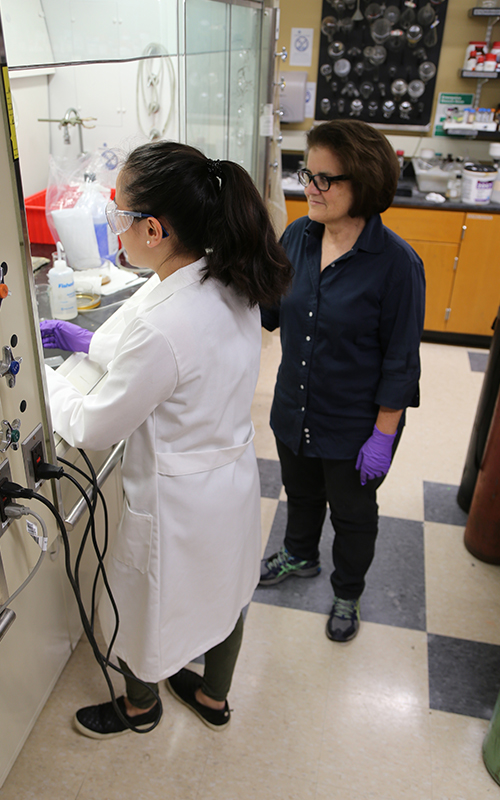Faculty Feature: Tayhas Palmore named inaugural Elaine I. Savage Professor of Engineering
Brown engineering’s first female full professor, Tayhas Palmore, awarded the endowed professorship named after engineering’s first female Ph.D. graduate, Elaine I. Savage.
 If you are lucky enough to get an audience with Tayhas Palmore, Brown University’s newly minted Elaine I. Savage Professor of Engineering, you leave with palpable excitement for the value science contributes to our evolving world. Her lab projects tend toward the underlying mantra of turning waste to worth.
If you are lucky enough to get an audience with Tayhas Palmore, Brown University’s newly minted Elaine I. Savage Professor of Engineering, you leave with palpable excitement for the value science contributes to our evolving world. Her lab projects tend toward the underlying mantra of turning waste to worth.
An electrochemist/materials engineer specializing in materials for energy conversion and storage, Palmore joined the Brown faculty in 2000, and co-founded the graduate program in biomedical engineering in 2002. A full professor since 2008, she now proudly shoulders the Elaine I. Savage Professor of Engineering title, alongside Professor of Medical Science and Professor of Chemistry. Her most prominent lab projects currently include chemicals derived from carbon dioxide and materials for low-voltage actuators.
“We are looking to create something of value,” she said. “Whether that be capturing carbon from fossil fuels, converting solar energy to something useful, or just taking CO2 out of the air.”
Efforts to mitigate global warming by carbon capture and storage technologies have recently included carbon dioxide (CO2) utilization technologies because of their potential to convert CO2 waste into marketable products. Carbon dioxide is an attractive target for development as a chemical feedstock due to its abundance, domestic availability, and low toxicity, as no other renewable carbon source is available on a scale similar to CO2. Full exploitation of this renewable resource is limited, however, by the kinetic and thermodynamic stability of CO2, which presents a significant scientific challenge for developing synthetic routes to CO2-based chemicals.
Palmore and her Ph.D. candidate Taehee Kim believe a promising method for utilizing CO2 is the electrochemical reduction of CO2 into fuels and chemicals under mild conditions (e.g. ambient pressure, moderate temperatures, safer solvents) using renewable energy as the driving force. Electrochemical reduction of CO2 involves several competing reaction pathways and is often studied at polycrystalline copper (Cu) because of its unique ability to produce hydrocarbons from CO2. The lab’s current research is improving product selectivity at polycrystalline Cu using chemical additives and novel processing that dramatically changes the surface morphology of this important catalyst.
A summer undergraduate teaching and research award also brought Kitty Moy ’21 to Palmore’s lab to focus on synthesizing and testing new films of electroactive polymers (EAPs), which are materials that function as actuators. EAPs based on soft materials are often referred to as artificial muscles because of their physical similarity to biological muscles and recent advances in EAP designs have resulted in significant shape changes with electrical input. Consequently, these materials are gaining attention for their potential use in biomimetic applications such as autonomous robotics at the smallest of scales. “Think about little microdrones,” Palmore explains. “They are used to go into caves, or fires, or on rescue missions where even dogs cannot go in to sniff.
The fun thing about working with Brown undergrads who are supported by UTRAs is that they can test the waters of a new project. Truthfully, that is one of the many things I love about working at Brown. There are fabulous students in a supportive learning environment.
“The fun thing about working with Brown undergrads who are supported by UTRAs,” she said, “is that they can test the waters of a new project. Truthfully, that is one of the many things I love about working at Brown. There are fabulous students in a supportive learning environment. Sometimes it’s like being a postdoc all your life, in that you can try new things, cross boundaries and retain freedom in intellectual pursuits.”

Palmore was officially named the Elaine I. Savage Professor of Engineering at the University’s Corporation Meeting in May.
“This is a wonderful opportunity to recognize the accomplishments and lasting contributions that both Tayhas and Elaine have made to Brown Engineering,” said Larry Larson, Sorensen Family Dean of Engineering, at the time of the announcement.
In 1976, Savage was the first woman to receive her Ph.D. from the Division of Engineering at Brown. Savage’s thesis title, “An Investigation of the Role of the Surface in the Mechanical Behavior of Polycrystalline Titanium,” was advised by Professor Donald H. Avery, who specialized in materials and structural engineering.
“I am honored to be the inaugural holder of this chair,” said Palmore. “Elaine Savage is a trailblazer for women engineers at Brown, and I am thrilled to be in this chair that recognizes and honors her. I met Elaine earlier in the semester, and she was very humble and gracious [about the eponym]. I sensed that Brown was a wonderful experience for her, just as it is for me.”